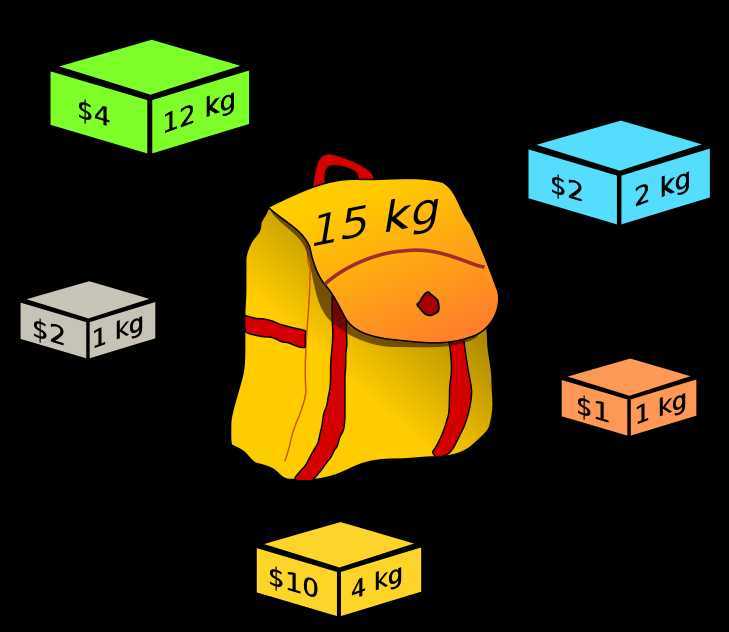标签:style blog http color io 使用 java ar strong
本文由 ImportNew - hejiani 翻译自 javacodegeeks。欢迎加入Java小组。转载请参见文章末尾的要求。
背包问题很有意思,同时也富有挑战性。首先看一下这个问题的完整描述:
假定背包的最大容量为W,N件物品,每件物品都有自己的价值和重量,将物品放入背包中使得背包内物品的总价值最大。

可以想象这样一个场景——小偷在屋子里偷东西,他带着一只背包。屋子里物品数量有限——每件物品都具有一定的重量和价值——珠宝重量轻但价值高,桌子重但价值低。最重要的是小偷背包容量有限。很明显,他不能把桌子分成两份或者带走珠宝的3/4。对于一件物品他只能选择带走或者不带走。
1 Knapsack Max weight : W = 10 (units) 2 Total items : N = 4 3 Values of items : v[] = {10, 40, 30, 50} 4 Weight of items : w[] = {5, 4, 6, 3}
从示例数据大致估算一下,最大重量为10时背包能容纳的物品最大价值为50+40=90,重量为7。
最佳的解决方法是使用动态规划——先得到该问题的局部解然后扩展到全局问题解。
构建物品X在不同重量时的价值数组V(Value数组):
1 V[N][W] = 4 rows * 10 columns
该矩阵中的每个值的求解都代表一个更小的背包问题。
初始情况一:对于第0列,它的含义是背包的容量为0。此时物品的价值呢?没有。因此,第一列都填入0。
初始情况二:对于第0行,它的含义是屋内没有物品。那么没有任何物品的背包里的价值多少呢?还是没有!所有都是0。

步骤:
1、现在,开始填入数组每一行的值。第1行第1列代表什么含义呢?对于第一个物品,可以把重量为1的该物品放入背包吗?不行。第一个物品的重量是5。因此,填入0。实际上直到第5列(重量5)之前都应该填入0。
2、对于第1行的第5列(重量5),意味着将物品1放入背包。填入10(注意,这是Value数组):

3、继续,对于第6列,我们可以再放入重量为1(重量值-物品的重量)的物品吗。我们现在只考虑物品1。由于我们加入物品1之后就不能再加入额外的重量,可以很直观地看到其余的列都应该还是相同的值。

4、接着,有意思的事情就要出现了。在第3行第4列,此时重量为4。
需要作以下判断:

简单来说,重量为4的前一行的值本身就是个更小的背包问题解,它的含义是到该重量时背包内物品的最大价值(通过遍历物品得到)。
举个例子:
计算过程如下:
1) 计算不放入该物品时该重量的最大价值:
1 previous row, same weight = 0 2 3 => V[item-1][weight]
2) 计算当前物品的价值 + 可以容纳的剩余重量的价值
1 Value of current item 2 + value in previous row with weight 4 (total weight until now (4) - weight of the current item (4)) 3 4 => val[item-1] + V[item-1][weight-wt[item-1]]
找到二者之中的最大值40(0和40)。
3) 下一次最重要的位置为第2行第9列。意味着此时重量为9,放入两件物品。根据示例数据现在可以放入两件物品。我们作了以下判断:
1 The value of the current item = 40 2 The weight of the current item = 4 3 The weight that is left over = 9 - 4 = 5 4 Check the row above. At the remaining weight 5, are we able to accommodate Item 1.

计算如下:
1. 不加入该物品时该重量的最大价值:
1 previous row, same weight = 10
2. 计算当前物品的价值+可以容纳的剩余重量的价值
1 Value of current item (40) 2 + value in previous row with weight 5 (total weight until now (9) - weight of the current item (4)) 3 4 = 10
10vs50 = 50。
解决了所有的子问题之后,返回V[N][W]的值——4件物品重量为10时:

解法的复杂度非常直观。在N次循环中有W次循环 => O(NW)
Java代码实现:
1 public class Knapsack { 2 public static void main(String[] args) throws Exception { 3 int val[] = {10, 40, 30, 50}; 4 int wt[] = {5, 4, 6, 3}; 5 int W = 10; 6 7 System.out.println(knapsack(val, wt, W)); 8 } 9 10 public static int knapsack(int val[], int wt[], int W) { 11 //Get the total number of items. 12 //Could be wt.length or val.length. Doesn‘t matter 13 int N = wt.length; 14 15 //Create a matrix. 16 //Items are in rows and weight at in columns +1 on each side 17 int[][] V = new int[N + 1][W + 1]; 18 19 //What if the knapsack‘s capacity is 0 - Set 20 //all columns at row 0 to be 0 21 for (int col = 0; col <= W; col++) { 22 V[0][col] = 0; 23 } 24 25 //What if there are no items at home. 26 //Fill the first row with 0 27 for (int row = 0; row <= N; row++) { 28 V[row][0] = 0; 29 } 30 31 for (int item=1;item<=N;item++){ 32 //Let‘s fill the values row by row 33 for (int weight=1;weight<=W;weight++){ 34 //Is the current items weight less 35 //than or equal to running weight 36 if (wt[item-1]<=weight){ 37 //Given a weight, check if the value of the current 38 //item + value of the item that we could afford 39 //with the remaining weight is greater than the value 40 //without the current item itself 41 V[item][weight]=Math.max (val[item-1]+V[item-1][weight-wt[item-1]], V[item-1][weight]); 42 } 43 else { 44 //If the current item‘s weight is more than the 45 //running weight, just carry forward the value 46 //without the current item 47 V[item][weight]=V[item-1][weight]; 48 } 49 } 50 51 } 52 53 //Printing the matrix 54 for (int[] rows : V) { 55 for (int col : rows) { 56 System.out.format("%5d", col); 57 } 58 System.out.println(); 59 } 60 61 return V[N][W]; 62 } 63 }
运行结果:
0 0 0 0 0 0 0 0 0 0 0
0 0 0 0 0 10 10 10 10 10 10
0 0 0 0 40 40 40 40 40 50 50
0 0 0 0 40 40 40 40 40 50 70
0 0 0 50 50 50 50 90 90 90 90
90
原文链接: javacodegeeks 翻译: ImportNew.com - hejiani
译文链接: http://www.importnew.com/13072.html
[ 转载请保留原文出处、译者和译文链接。]
本文来源:http://www.importnew.com/13072.html
标签:style blog http color io 使用 java ar strong
原文地址:http://www.cnblogs.com/dwf07223/p/3983896.html